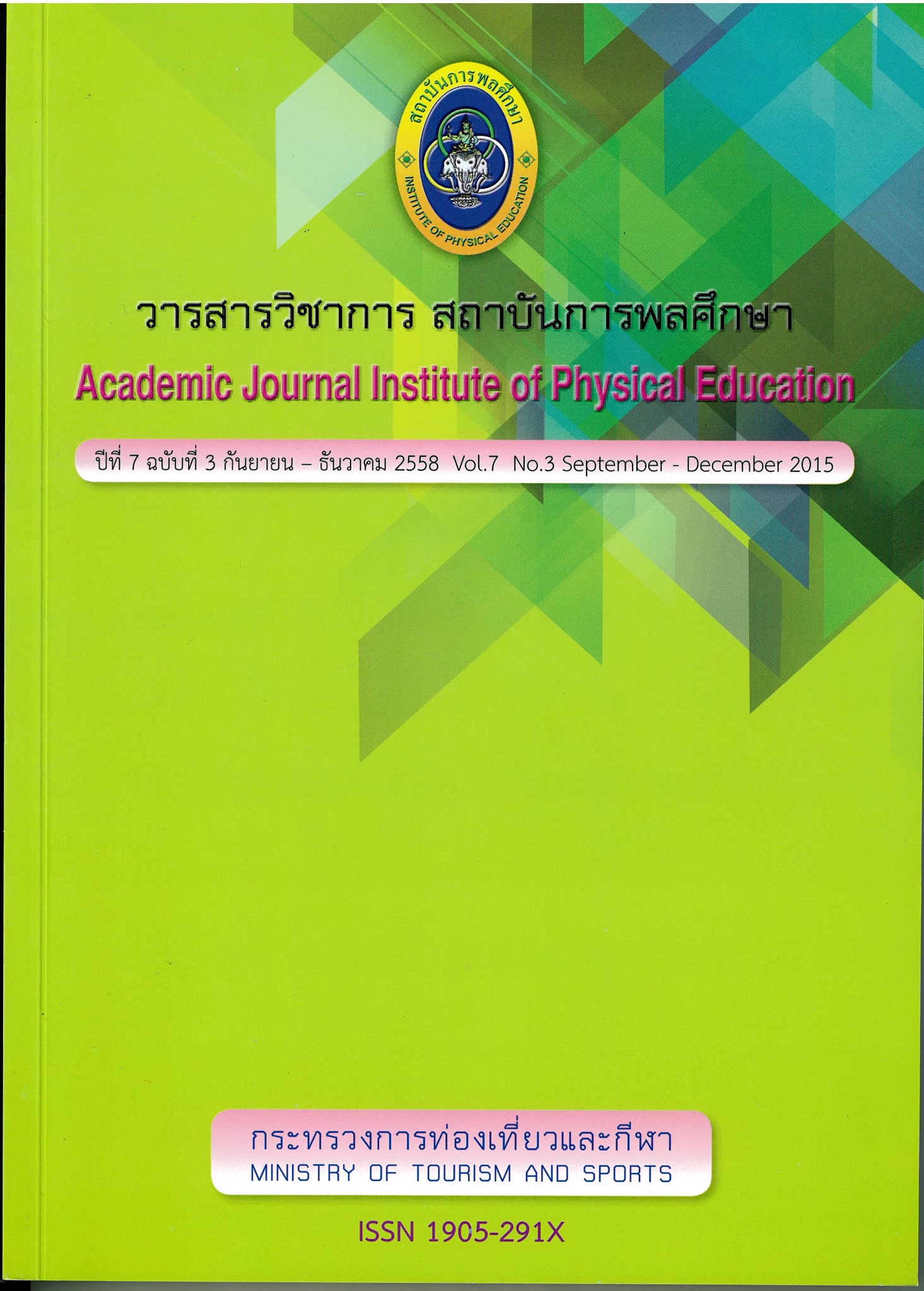The study of perception, attitude and participation of the spectators attending the sports competition held by Institute of Physical Education toward sport tourism
Main Article Content
Abstract
The Purposes of this study were: 1) to study of perception, attitude and participation of the spectators attending the sport competition held by Institute of Physical Education 2) to propose ways of promoting sport tourism. This research was a mixed method research which was mixed between quantitative research and qualitative research. Population and samples were the spectators attending the 39th Institute of Physical Education Games at Srisaket. This research used Krejcie and Morgan table for sample size determination. The population of the study was 7,000 spectators. The 364 samples were selected from the total number using confidence random sampling method. In keeping data collecting clear from error, the researcher increased the sample size to 400 using convenience random sampling method. The instrument used for data collecting is questionnaire. Descriptive statistics used to describe the data were mean, standard deviation, and percentage.
The findings revealed that:
- Eighty percent of the spectators' perception and behaviors have an impact on sport tourism;
- The spectators' attitude on sport tourism was at high level with the arithmetic mean of 4.19;
- Eighty percent of the spectators' behaviors have an impact on sport tourism;
- Based on the major findings, the following ways of promoting sport tourism were suggested: 1) Sport tourism outside the competition arena; 2) Sport tourism inside the competition arena; ฝึก 3) Tour packages for those being interested in sport tourism.
Article Details

This work is licensed under a Creative Commons Attribution-NonCommercial-NoDerivatives 4.0 International License.
The published article is a copyright of the Academic Journal of Thailand National Sports University. The passage appeared in each article in this academic journal is a perspective of each author which is not related to the journal. Each author is required to be responsible for all components of his/her own article. If there are any mistakes, each author must be responsible for those mistakes on his/her own.
References
เดชา โต้งสูงเนิน. (2543). การบริหารจัดการการท่องเที่ยวเกษตร : กรณีศึกษา บ้านม่วงคํา ตําบลโป่งแยง อําเภอแม่ริม จังหวัดเชียงใหม่, เชียงใหม่: มหาวิทยาลัยเชียงใหม่.
บุญเลิศ จิตตั้งวัฒนา. (2542). การวางแผนพัฒนาการท่องเที่ยว, รายงานวิจัย, เชียงใหม่.คณะมนุษยศาสตร์ มหาวิทยาลัยเชียงใหม่,
บุญชม ศรีสะอาด. (2532) วิธีการทางสถิติสําหรับการวิจัย เล่ม 1. กรุงเทพฯ : ภาควิชาพื้นฐานของการศึกษา คณะศึกษาศาสตร์ มหาวิทยาลัยศรีนครินทรวิโรฒ มหาสารคาม.
วิลาศ ศรีพายัพ (2534), การวัดเจตคติต่อการกีฬาตามแนวของลิเคอร์ทกับแนวของอ๊อสกูด. วิทยานิพนธ์ศึกษาศาสตรมหาบัณฑิต สาขาวิชาการวัดและประเมินผลการศึกษา มหาวิทยาลัยเชียงใหม่.
Adriana. (1997). Tourism Development in Mountain Centers in the Anders of Patagonia. Forum Online Library Document. Doctoral Thesis.
Bernthal, M.J. and Graham, P.J. (2003) “The effect of sport setting on fan attendance motivation: the case of minor league vs. collegiate baseball', Journal of Sport Behavior, Vol. 26, No. 3, pp.223-239.
Branscombe, N. R., &Wann, D. L. (1994). Sport psychology.In Magill's survey of social sciences: Psychology (pp.2363-2368). Pasadena, CA: Salem Press.
Funk, D. C., Mahony, D. F. and Ridinger, L.L. (2002) Characterising consumer motivation as individual difference factors: Augmenting the sport interest inventory (SII) to explain level of sport, Sport Marketing Quarterly, 11, 33-43.
Gantz, W., &Wenner, L. A. (1995).Fanship and the television sports viewing experience. Sociology of Sports Journal, 12, 56-74.
Gantz, W., &Wenner, L. A. (1995). Televised sports and marital relationships. Sociology of Sports Journal, 12, 306-323.
Hall, Peffer and Puter Norris. (1993). “Learning for leadership“ Leadership & Organization Journal. 14 (7): 35-40.
Krejcie, R. V. & Morgan, D. W. (1970). Determining Sample Size for Research Activities. Educational and Psychological measurement, 30(3), pp. 607-610.
Lever, J., & Wheeler, S. (1984). The Chicago Tribune sports page, 1900-1975. Sociology of Sport Journal, 1, 299-313.
Neal, T. (2006). Lead like an entrepreneur. New York: McGraw-Hill.
Rozaki, Adman Ali. (1987). "Analysis of Social - economic Factors on Students Academic Achievement in the Preparatory Academic Schools in Iraq” , Dissertation Abstracts International. 48 (December 1987), 1372 - A..
Sloan, L. R. (1989). The motives of sports fans.In J. H. Goldstein (Ed.), Sports, games, and play: Social and psychological viewpoints (2nd ed., pp. 175-240). Hillsdale, NJ: Erlbaum.
Trail, G.T. & James, J.D. (2001). The motivation scale for sport consumption: Assessment of the scale's psychometric properties. Journal of Sport Behavior, 24(1), 108-27.
Wann, D. L., &Branscombe, N. R. (1995). Influence of identification with a sports team on objective knowledge and subjective beliefs. International Journal of Sport Psychology, 26, 551-567.
Wann, D. L., &Branscombe, N. R. (1995). Author and subject gender in sports research. International Journal of Sport Psychology, 26, 225-232.
Wann, D. L., &Branscombe, N. R. (1999). Assessing the psychological well-being of sport fans using the Profile of Mood States: The importance of team identification. International Sports Journal, 3, 81-90.
Weed, M. and Bull, C. (1997) Influences on Sport-Tourism Relations in Britain: The effects of Government policy, Tourism andRecreation Research, 222(2), 5-12.
Gammon, Sean, and Tom Robinson. (1997). Sport Tourism: A Conceptual Framework. Journal of Sport Tourism 4(3).
Gibson, E. Babyonyshev, M., Kaan, E., 1998a. (1998). Sentence reanalysis: generalized incremental processing within a parallel processing framework. Poster presented at the 11th CUNY Sentence Processing Conference, Rutgers, NJ, March, 1998.
Zillmann, D., Bryant, J., &Sapolsky, B.S. (1989). Enjoyment from sports spectatorship. In J. H. Goldstein (Ed.), Sports, games, and play: Social and psychological viewpoints (2nd ed., pp. 241-278). Hillsdale, NJ: Erlbaum.


